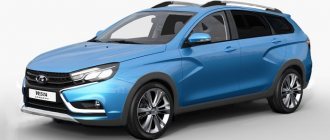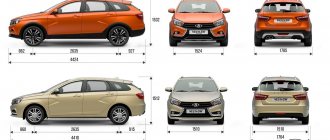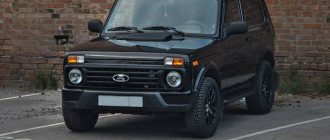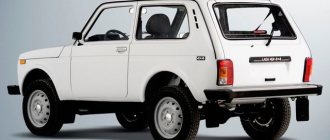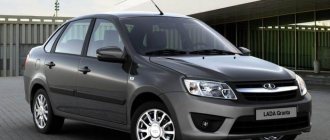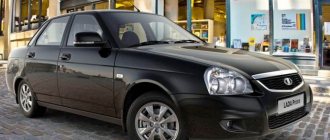Despite the American name, Chevrolet Niva (Chevrolet Niva) is a completely domestic mass-produced car that belongs to the “D” class.
Regardless of generation, models are equipped with permanent all-wheel drive, a two-speed transfer gearbox, and a locking differential.
During 2004 - 2009, the Chevrolet Niva was one of the best-selling cars in the CIS, Russia, among others.
Brakes
Chevrolet Niva
benefit up to 320,000
Loan from 0%! No down payment! Mathematical capital for the purchase of a car!
TECHNICAL CHARACTERISTICS OF CHEVROLET NIVA (CHEVROLET NIVA)
Of course, the first and main feature that defines the very essence of the Chevrolet NIVA is all-wheel drive. High cross-country ability, in addition, is ensured by the center locking differential and other important technical characteristics of the Chevrolet NIVA.
Thanks to its compact dimensions and body shape, the car is distinguished by high maneuverability and geometric cross-country ability: it is stable, easily copes with ruts, holes, and fords.
The SUV's transfer case is equipped with a low range of gears - an indispensable assistant in difficult off-road areas and when towing.
A sensitive and driver-friendly clutch, as well as increased heat resistance of the linings, provide additional confidence in difficult places and when rocking.
Chevrolet Niva
benefit up to 320,000
Loan from 0%! No down payment! Mathematical capital for the purchase of a car!
The lineup
Sections of the site
Source
Export
From 2002 to 2015, 42,326 vehicles were exported. The model is implemented only in the CIS countries, as well as in Georgia; The main markets are the countries of the Customs Union (Kazakhstan, Belarus), as well as Azerbaijan.
Until 2013, the largest foreign market for GM-AVTOVAZ was traditionally Ukraine - in 2011, this country accounted for 44% of Chevrolet Niva exports. In 2013, Ukraine introduced a recycling fee and a special duty on the import of cars with gasoline engines, which led to the fact that Chevrolet Niva exports to Ukraine fell by a quarter in the first six months of 2013, amounting to 219 units.
At the end of 2014, 3981 Chevrolet Niva were exported - 79.7% of exports went to Kazakhstan, 11.1% to Belarus, 5.6% of exports went to Azerbaijan.
In 2015, it is planned to export about 3.5 thousand Chevrolet Niva cars.
Trunk and main technical characteristics of the Chevrolet Niva. Dimensions of Niva Chevrolet
But in those days, the Tolyatti auto giant was experiencing difficult times for the first time and, as you might guess, there were no funds for a production version. The plant was forced to look for large investors to launch a pilot project at the initial stage. And after a series of refusals from different companies, the American giant General Motors responded. This company bought the production license. This is how the new Chevrolet Niva appeared.
Serial production was launched only in 2003. But due to numerous changes, the price of the car increased significantly, which could not make the Chevrolet Niva another people's car, as was the case with the VAZ 2121. After an outright failure on the Russian market, the American company bought the license for the 2121. Now it became known as the Lada 4× 4. So two Nivas appeared on the Russian market in different price categories.
Which car is better to buy - before or after restyling?
Improvements were made to the design of the Chevrolet Niva in 2009, which were aimed at increasing the reliability and comfort of the domestic SUV.
Main changes:
- the appearance of new wheel arches and plastic body kits for additional protection from dirt and stones;
- changes in lighting, new lamps began to provide better quality light;
- the body was adapted to a stylish modern design;
- the car received a new interior for more comfortable and safe driving;
- other improvements - changes in the design of electrical equipment, engine, transmission, etc.
As can be seen from the review, after restyling the car has become more modern, more comfortable and convenient.
Such an SUV will cost a little more. But when you buy it, you will receive an excellent car, in which all the shortcomings have been eliminated, taking into account the feedback from the owners of the first series.
The advantages of such machines include the low price that the secondary market offers us. When purchasing, it is important not to make a mistake with your choice and be sure to visit a car service for diagnostics.
Chevrolet Niva dimensions, dimensions, volumes, Chevrolet NIVA 4x4 ground clearance, trunk
The dimensions of the Chevrolet Niva classify this 5-door crossover as a very compact car. In fact, the length of the Chevrolet NIVA does not exceed 4 meters.
However, such compact dimensions, combined with high ground clearance, which is more than 20 centimeters, and small overhangs, make the small crossover ready for any off-road obstacles. In the photo at the beginning of the article you can see all the main linear dimensions of the Chevy Niva. I would like to immediately note that the official dimensions given by the manufacturer and actual measurements may give different results.
Let's say the clearance or ground clearance of a Chevrolet Niva can vary from 20 to 24 centimeters. The difference depends on where you measure. For example, the lowest point in the Chevrolet NIVA is in the rear, under the bridge. You can measure the ground clearance of the Shnivy under the engine protection in the front. In addition, the manufacturer itself allows the installation of both 15 and 16-inch wheels on the car; add off-road high-profile tires to them and the ground clearance will be even higher.
Below are more detailed characteristics of the dimensions of the Chevy Niva.
As for capacity, five adult men in the Chevrolet NIVA, to be honest, will be cramped. The wheelbase, which determines the spaciousness in the cabin, is only 2450 mm. Therefore, traveling long distances in a large group may not be enjoyable.
The trunk of the Chevrolet Niva is relatively small, only 320 liters. However, if you fold the seats in the Shnivo, you get 650 liters of volume. A photo of the trunk with the rear seats folded is attached, see above.
The problem of lack of space is solved by roof rails, where you can install an additional luggage rack. But it is worth considering the fact that in the basic version the Chevy Niva simply does not have roof rails. Therefore, before buying a car, you should consider whether you need an additional roof rack.
How much does a car “eat”?
The main question for all SUV lovers is fuel consumption per 100 km, which is always higher for all-wheel drive models. Chevrolet Niva is not very economical. The manufacturer officially states that the combined cycle will consume 10.2 liters of fuel. But in the city and on the highway, a lot depends on driving style.
According to real reviews from car owners, the consumption is slightly higher:
- track – 9-10 l;
- city, taking into account traffic jams - 13-14 l;
- mixed cycle - 11-12 liters.
This “appetite” of the engine compensates for the tank capacity. The Chevrolet Niva has a filling capacity of 58 liters. If you fill fuel up to the neck, you get another +2 liters. This is enough for about 500 km. But it's better to refuel a little earlier.
Installation
In most cases, installation is carried out independently. It is better to mount expeditionary racks with the help of a friend, since it will be much easier to do it with 4 hands.
Focus on the features of the selected trunk. In some models, the fastening is made there, so that you have to remove the trim elements in the cabin. Otherwise, installation does not involve any complex manipulations. The process looks something like this.
Installation may vary slightly depending on the roof rack selected. Therefore, rely on the factory installation instructions. Dismantling is carried out in the same way, only, as you understand, in the reverse order of your actions.
Did you think this was where we would start saying goodbye to you? Well, I do not. You won't wait. First, I will tell you about another option for the trunk. It's like a trunk within a trunk that you access when you open the rear tailgate.
Niva Chevrolet overall dimensions
The overall dimensions of the Chevrolet Niva SUV are considered quite compact, and its length is no more than four meters. But despite this, thanks to its high ground clearance, which is more than twenty centimeters, it is ready for any obstacles associated with difficult to pass places. The picture below shows all the characteristics, but I would like to note that they may differ slightly from the sizes indicated by official manufacturers, since in fact they are different. For example, clearance can be indicated from 20-24 cm, since it depends on where the measurement is made. It is measured at the lowest point and is located in the rear of the car, and usually under the bridge, but they can indicate the distance from the engine protection to the ground and therefore the readings will be different. The SUV also comes from the factory with 15 and 16 inch wheels, which also affects what the ground clearance will be.
Dimensions and technical characteristics of the vehicle
The interior is no larger in size and if, for example, five adult men go on a trip, it will be uncomfortable. The wheelbase, which plays a decisive role in the spaciousness of the cabin, is 2450 millimeters. Therefore, if you decide to ride it long distances with a larger group, this may cause you great inconvenience.
As for the trunk of the Chevrolet Niva, it is small and its size is 320 liters, but if you fold the rear row of seats, it increases to 650 liters. The problem with the lack of space for luggage can be solved by installing roof rails and placing an additional box on them. The factory equipment does not include roof rails, so when purchasing this SUV you need to immediately decide whether you need them or not.
Conclusion
To summarize, we can conclude that this is a compact car, which can rightfully be classified as an SUV, which meets all modern requirements, and is ideal for:
Despite its compactness, this car is a universal compact all-wheel drive SUV with increased cross-country ability, which has a durable supporting structure and reliable components and assemblies.
Features of luggage compartments
To summarize, let’s say that the Niva’s trunk is really small in volume – less than 400 liters. But due to the space freed up after the rear seats are removed, it becomes more spacious. Railings became a bonus for some models. You can finish the conversation about the features of the Chevy trunk with a simple comparison with the Granta liftback.
With a volume of 440 liters in the Granta's trunk, its capacity, as practice shows, is significantly lower due to the peculiarities of the geometry of the space. The square trunk of the Niva turns out to be much more rational to use than the Grant one, which is more voluminous in terms of technical characteristics, but is “cut off” by the inclined glass of the door.
The car does not have a truly spacious trunk. Therefore, before purchasing, you should decide how important this criterion is for you, and choose a car model based on this.
Motor
The engine, although old in design, has been modernized many times. Therefore, the resource is taking care of it quite vigorously and is ready to provide careful owners with 250-300 thousand km without major repairs.
The main problem with the engine is the cooling system. They say it works to the limit, hence all the problems that arise, in the literal sense. Watch for leaks and do not turn the motor so as not to overheat it and overload the heat removal system.
The thermostat and expansion tank may fail (it bursts from the cold). Tip: Carry a spare one in your trunk.
The second known problem is the timing chain (it stretches and can jump over the teeth). The result is a major engine overhaul. A hint about a possible problem can be obtained when the engine is running. If the chain is loose, mechanical noise appears when the engine runs.
A breakdown of the throttle sensor also does not add reliability points to the Chevrolet Niva.
Of the least big problems: the knocking of hydraulic compensators can be heard.
Technical characteristics of the Chevrolet Niva
| L | L.C. | GLS | |
| Characteristics | |||
| Working volume | 1690 cc | ||
| Number/arrangement of cylinders | 4 cylinders | ||
| Diameter | 80 mm | ||
| Piston stroke | 82 mm | ||
| Maximum speed | 140 km/h | ||
| Acceleration 0-100 km/h (sec.) | 19 s | ||
| Chevy Niva transmission | Manual 5-speed transmission | ||
| engine's type | Petrol | ||
| Chevrolet Niva power | 80 HP/58.5 kW@5000 RPM | ||
| Torque | 127.5 N*m@3800 RPM | ||
| Dimensions | |||
| Shnivy Length | 4056 mm | ||
| Width | 1800 mm | ||
| Height | 1690 mm | ||
| Height excluding roof rails | 1652 mm | ||
| Wheelbase | 2450 mm | ||
| Front wheel track | 1466 mm | ||
| Rear wheel track | 1456 mm | ||
| Minimum turning radius | 5.8 m | ||
| Luggage compartment volume with rear seats up | 320 l | ||
| Luggage compartment volume with rear seats folded | 650 l | ||
| Ceiling height above front seats | 910 mm | ||
| Ceiling height above rear seats | 875 mm | ||
| Fuel tank volume | 58 l | ||
| Maximum permissible weight | 450 kg | ||
| Ground clearance | 200 mm | ||
| Wheel size | R15 Wheel size | R16 Wheel size | |
| Tire size | 205/75 R15, 205/70 R15 Tire size | 215/65 R16 Tire size | |
| Seat comfort | |||
| 60/40 split folding rear seats | |||
| Heated front seats | |||
| Ease of control | |||
| Central locking with remote control | |||
| Front electric windows | |||
| Mirrors | Electric rear view mirrors/Heated rear view mirrors | ||
| Full size spare tire | |||
| Microclimate and heating | |||
| Air conditioner | — | — | |
| Heated rear window | |||
| Anti-theft protection | |||
| Engine immobilizer | |||
| Anti-theft alarm system | |||
| Wheel disks | |||
| 16" alloy wheels | |||
| Steel rims 15″ Niva | |||
| Fuel efficiency | |||
| Emission Level/Environmental Compliance | Ecological class Euro IV | ||
| Fuel consumption *: urban cycle | 14.1 l/100km | ||
| Fuel consumption *: extra-urban cycle | 8.8 l/100km | ||
| Fuel consumption *: combined cycle | 10.8 l/100km | ||
| CO2 emissions | 245 g/km | ||
| Safety | |||
| Front fog lights | |||
| Front seat belt pretensioners | |||
| ABS | |||
| Driver and front passenger front airbags | |||
| External equipment | |||
| Rear view mirrors in body color | |||
| Bumpers in body color | |||
| Door handles in body color | |||
| Tinted glass | |||
| Internal equipment | |||
| Sunglasses Storage Case | |||
| Pocket in the back of the driver's seat | |||
| Pocket in the back of the front passenger seat | |||
| Exterior colors | |||
| Asteroid | |||
| Auster | |||
| wild plum | |||
| Extravaganza | |||
| Quartz | |||
| Milky Way | |||
| Sochi | |||
| The Snow Queen | |||
| Upholstery | |||
| Fabric trim | |||
| Combined interior trim | |||
Special series
Special series 2009
In the fall of 2009, to mark the 7th anniversary of the start of production of the model, 150 Chevrolet Nivas were produced in the exclusive Black Uni color (black non-metallic). The GLC trim adds chrome accents to the interior and silver-painted exterior door handles and roof rails, as well as stylish wheel rims to the exterior.
Special series 2010
In the summer of 2010, at MIAS 2010, a light lilac version of the “Lilac” color, produced in a series of 300 cars, was presented, equipped with white turn indicators, 16-inch Vicom alloy wheels, a chrome-plated spare wheel cap, factory tinting, roof rails and a front bumper skid.
Special series for the 100th anniversary of the Chevrolet brand
In 2011, a special series of 300 cars was released to mark the 100th anniversary of the Chevrolet brand. The special series was executed on the LC configuration platform, supplemented by the presence of a snorkel, engine protection, tow bar, and K&K Kamelot Black wheels. The anniversary cars were painted in the production colors of dark gray-green metallic “Sochi” (250 units) and bright red metallic “Feriya” (the remaining 50).
Special Edition (SE) Tundra color
In the fall of 2014, a limited number of the Chevrolet Niva Special Edition (SE) was released in “Tundra” color (silver-green metallic, code 395 BASF) dedicated to the 12th anniversary of the start of production of the model. The equipment was created on the basis of the LE equipment, and differed from it in color, K&K “Legion” alloy wheels, leather steering wheel, underbody protection, fog lights, heated seats, tinting, floor mats and a stainless steel shovel on the tailgate.
Niva Chevrolet trunk volume
Chevrolet Niva belongs to the class of compact crossovers. The length of this 5-door car is just under 4 meters, making it convenient to use not only off-road, but also in urban conditions, allowing you to successfully maneuver in traffic flows.
But compactness in this case is successfully complemented by high ground clearance, amounting to as much as 20 centimeters at the lowest point. And the body kit system with small angles allows you to overcome any obstacles and forever forget about the problem of parking near curbs.
In more detail, you can familiarize yourself with the technical characteristics of the car in the diagram presented in the figure. These are the official dimensions determined by the manufacturer. It should be understood that in reality some parameters may differ. For example, ground clearance: under load or certain suspension parameters, it can vary from 20 to 24 centimeters. The lowest point is located near the car in the area of the rear axle. The diameter of the wheels installed on the car is also of great importance. And installing high-profile tires can immediately add a few more centimeters. The level of ground clearance can also be affected by the installed engine protection.
Official data on the size of the Chevrolet Niva car is as follows:
The vehicle's capacity can accommodate four adult men, but there may not be enough space. This is mainly determined by the wheelbase, which is only 245cm. This can also affect the comfort of the trip. The car turned out to be a little short, so it might feel a little rough when driving. But, this car model is not intended for long-distance travel, but for off-road driving, where a small wheelbase is more likely to be an advantage.
In the Niva Chevrolet, the trunk volume is 320 liters. But folded seats, forming a long, flat floor, allow you to increase the volume to 650 liters. Also, the lack of space in the trunk can be solved by installing roof rails for the use of additional trunk space.
Comparison with competitors
Today, the Chevrolet Niva has competitors and there are not so few of them. Each vehicle has its own advantages and disadvantages. The most common competing cars on the market include Ssang Yong Actyon, Kyron and Rexton, as well as Suzuki Grand Vitara, TagAZ Tingo, Renault Duster, Chery Tiggo, Great wall H3. You can also mention domestic rivals, represented by UAZ Patriot, Lada Niva and UAZ Hunter.
There are also other models of this division, but they already have a different pricing policy. Many people consider Renault Duster to be the most direct rival of the Chevrolet Niva. This is the most familiar or advertised car of the ones listed above.
Initially, you can pay attention to the data of the power unit
If we compare the “French” with the domestic version, then already in the basic version the power plant of the Renault Duster is more powerful. This seriously increases its appeal among SUV connoisseurs who travel more in urban areas and on the highway. Some people think that the off-road qualities of the Renault Duster are enough for country trips, but for dirt and serious off-road use a stronger clutch is needed, as well as an increased ride height.
https://youtube.com/watch?v=vNRsMh5fdnI
Although the comfort level of Renault Duster meets many of the criteria of modern drivers. Although the French crossover has higher power than the Chevrolet Niva, it also costs an order of magnitude more. As for the transmission, the Niva has a selectable overdrive and a mechanical differential lock, while the Duster has an electronic clutch for switching between 3 driving modes.
The equipment level is also better and richer for the French car. Therefore, the final option must be made by the buyer himself, guided by his priorities.
OFF-ROAD
Next to the Niva gearbox lever there is a lever that controls the transfer case. By moving it back (position H) the higher row of the transfer case is switched on, and forward (to position L) – the lower row; between them is “neutral”, in which torque is not transmitted to the wheels. The lower row allows you to increase the overall transmission ratio (torque at the wheels) in any gear by 2.1 times. By moving the lever to the left (in any position), the center differential is blocked: a rigid connection is created between the front and rear axles. Helps on slippery ascents and descents, on very rough terrain, when there is a high probability of one of the wheels hanging out, as well as when starting off, when the wheels of one of the axles are on a surface with a lower coefficient of adhesion than under the wheels of the other. It is strictly forbidden to use a blocker on roads with a high coefficient of traction.
The all-wheel drive Duster transmission has three modes. You can select them by turning the large “button” on the console.
2WD - front wheels only. Used for dry roads with a high coefficient of traction.
Technical characteristics of Chevrolet Niva
For residents of the Russian outback, you probably won’t find a better car than the Chevrolet Niva. Of course, there is such a legendary car as the Lada 4×4, but unlike the Niva 212300, it does not have such comfort and convenience while driving, so this car is the best on the Russian market.
History of appearance
This SUV first appeared back in 2002, although this could have happened even earlier, since AvtoVAZ back in 1998 prepared a project according to which the VAZ-2123 was supposed to replace the outdated Niva 2121. But since there was no money for mass production of the new product its license was sold to the foreign concern General Motor, after which a year later more than a thousand changes were made and in 2002 the first generation cars were released.
This Chevrolet Niva SUV was restyled in 2009, thanks to which it received a more modern look and began to look more like Chevrolet’s corporate style. Of course, it’s difficult to call this SUV a standard of beauty, although overall this car looks quite decent, practical and recognizable. Despite the fact that the car is compact, it has a high ground clearance, which increases its off-road properties, as well as the presence of a well-balanced body proportion.
Of course, the interior of this car is not entirely spacious, this is especially felt when you sit in the back row, where there is very little space in the legs. However, for the driver there is a very ergonomic space, where the center console is located at a convenient angle, and thanks to the larger expanse of glass, it has excellent visibility and a comfortable seating position, this is especially felt in the Chevrolet Niva released at the beginning of 2014. Thanks to the fact that the SUV has modern seats with a new headrest and little lateral support.
Significant advantages of this car include the trunk, the size of which is 320 liters, and if you fold the rear seats of the second row it will reach 650 liters. Due to the fact that there is no threshold in the trunk and a wide doorway, loading and unloading luggage occurs without any difficulties.
Technical characteristics of the Chevrolet Niva:
At the moment, one power plant option is proposed. It is a conventional naturally aspirated gasoline engine with four cylinders with a total volume of 1.7 liters with a sixteen-valve timing belt and a five-speed manual transmission. Thus, the car fits into all Euro standards. Gasoline consumption in the city is approximately fourteen liters, on the highway - eight and a half, in the combined cycle - about ten.
It is worth adding that in the period from 2006 to 2008 there was a modification that was equipped with a 1.8 liter engine with 122 horsepower.
The basis of the Chevrolet Niva is a monocoque body with an independent front spring, an independent five-rod rear spring and a suspension with double wishbones. A disc brake is located on the front axle of the SUV, and conventional drum brakes on the rear axle. The brake system is complemented by a vacuum booster, and newer ones already have an ABS system. The rack and pinion steering mechanism works in conjunction with the power steering. All modifications are equipped with permanent all-wheel drive, with a two-speed transfer case based on a center locking differential. High ground clearance and compact dimensions, coupled with all-wheel drive, provide excellent maneuverability, as well as excellent stability on corners and slippery roads.
Key Features:
Description of design advantages:
Chevrolet Niva technical characteristics and shortcomings in the interior:
Crash test
The Chevrolet Niva has all the best off-road characteristics from the previous version 2121. The domestic SUV received not only a fresh look
When creating, the development department paid special attention not only to appearance. Some additional design solutions have been added that allow us to come a little closer in terms of quality and comfort to foreign cars
Today, a car has all the necessary modules to become a truly convenient and comfortable car. During full crash tests, it became clear that due to the limited engine compartment, when comparing the model with the previous car, there was an urgent need to install airbags. During testing, the main damage occurs to the lower part of the body.
After a crash test of the Chevrolet Niva, it was noticeable that the lower part of the car was severely dented, and the rims were also deformed. After the impact, the steering wheel hit the dummy so hard that it became oval. The most important reason for this is insufficient body strength. But it is the body that should provide the main protection for passengers during a frontal collision. This can cause serious injury to the driver.
The strapped upper torso is not as affected as the lower torso, which may be pinched when the floor is deformed. The displaced clutch mechanism, as well as the pedal assembly itself, also raise concerns. This can cause serious lacerations. The first models of the SUV suffered from displacement of the lower body latches during a collision. But later they began to use the most durable body structure.
After reading the Chevrolet Niva crash test, it becomes clear that the body is the most unprotected place in this vehicle. When it is damaged, a rupture appears in the steering column, the clutch mechanism fails, so the chance of various injuries for the driver and front passenger increases. Therefore, now the car has a body reinforcement with protection of the clamps from rupture.
The doors have metal bars that protect against lateral collisions and excessive lateral deformation. However, this is not enough - judging by the international specification system, the Chevrolet Niva can be classified only in the middle safety segment among passenger vehicles.
Technical characteristics of Chevrolet Niva - 1.7 engine, fuel consumption, body dimensions
The compact SUV Chevrolet Niva has been produced since 2002 at the facilities of the GM-AVTOVAZ joint venture in the city of Tolyatti. Throughout its existence, the car has remained virtually unchanged from a technical point of view. The model is based on the VAZ-2123 platform, which assumes the presence of an independent 2-link suspension at the front and a continuous axle at the rear.
Chevrolet Niva is a real SUV with “honest” all-wheel drive, which is implemented using a transfer case that distributes torque between the front and rear axles in a 50/50 ratio. A lowering row, an interaxle locking mechanism and good body geometry significantly increase the vehicle’s capabilities in off-road conditions. The car feels no less comfortable in a dense urban environment, where the compact dimensions of the body are a plus - 4048x1770x1652 mm.
Engine Chevrolet Niva 1.7 VAZ-2123
A 1.7-liter VAZ-2123 engine has been installed under the hood of the car since the start of production. The unit is a variation of the VAZ-21214 engine, adapted specifically for the Chevrolet Niva. The engine is equipped with a cylinder block made of high-strength cast iron, a timing belt with an overhead camshaft and a chain drive (single-row chain with tensioner), a distributed injection system, a valve mechanism with hydraulic compensators (adjustment of valve clearances is not required). The cylinder diameter is 82 mm, the piston stroke is 80 mm, the compression ratio is 9.3. The maximum output power of the engine does not exceed 80 hp, peak torque is 127.5 Nm (at 4000 rpm).
The VAZ engine of the Chevrolet Niva is not highly reliable. Its disadvantages include high levels of noise and vibration, high fuel consumption, a tendency to burn oil, and a short service life (in practice, no more than 150-200 thousand km). It was possible to increase the efficiency of the power unit through modernization carried out in 2015. As a result of the update, not only the fuel appetite decreased (by 2-4%), but also the amount of harmful emissions was reduced. This allowed the VAZ-2123 engine to comply with Euro-5 standards. The average fuel consumption of the Chevrolet Niva 1.7 is now 10.2 liters per 100 km (in the city - 13.2 liters, on the highway - 8.4 liters).
Characteristics of the 1.7 VAZ-2123 Chevrolet Niva engine:
| Engine code | VAZ-2123 |
| Cylinder block material | cast iron |
| engine's type | petrol |
| Supply system | distributed injection with electronic control |
| timing belt | SOHC |
| Number of cylinders | 4 |
| Cylinder arrangement | in-line |
| Number of valves | 8 |
| Cylinder diameter, mm | 82 |
| Piston stroke, mm | 80 |
| Compression ratio | 9.3:1 |
| Cylinder operating order | 1-3-4-2 |
| Working volume, cubic meters cm. | 1690 |
| Power, hp (at rpm) | 80 (5000) |
| Torque, N*m (at rpm) | 127.5 (4000) |
| Weight, kg | 122 |
| Resource (in practice), thousand km | 150-200 |
Modification of Chevrolet Niva 1.8 122 hp.
It is interesting that in the period 2006-2008, along with the VAZ engine, the Chevy Niva was equipped with a 1.8-liter Z18XE unit from Opel. It had more attractive technical parameters - power 122 hp. and torque 167 Nm. Paired with the 1.8 engine was the same 5-speed manual transmission. This version was not in great demand due to its high price, so it was subsequently withdrawn from the market.
Mechanical transmission and transfer case breakdowns
Chevrolet Aveo 2010 technical specifications, configurations and prices
“The most common problem in these boxes is the knocking out of fifth and reverse gears. There is only one reason - the gear selector mechanism is not adjusted. The input shaft bearing may “die” in the region of 50-60 thousand km,” - this is an example of problems with the gearbox given on the website polomkiauto.ru
Sometimes a hole leaks in the area where the speedometer cable drives.
According to the advice of experienced people, it is better to change the gearbox oil more often, once every 50 thousand km.
In a transfer case, it is normal for the seals to leak. In fact, the oil itself on the gearbox, drives and transfer case housing does not indicate a big problem. The seals on many cars “sweat” oil, including foreign premium models. The main thing is not to leak.
Otherwise, transmission breakdowns do occur, but generally not critical. Although, if you don’t like tinkering with your car, the following list of breakdowns will seem like a disaster to you (the list is taken from the website www.drive2.ru, from the page of a user under the nickname wladimir1990)
32,000 km – replacement of the rear oil seal
at 34,000 km vibration appeared at a speed of 90 km/h (it was not felt when cold), accordingly the following was done:
wheel balancing and wheel alignment (didn’t help)
39,900 km - replacing the shaft with a 2-CV joint hammer and sickle (did not help)
balancing drive shafts (normal)
46,200 km – replacing the transfer case (did not help)
in the end, the vibration was not defeated - I resigned myself (58,000 km - the front gearbox was rebuilt, because it was leaking from all the seals, the result was that it began to leak through the gasket)
RENAULT DUSTER
1. Multi-link rear suspension of a modern design is the key to a smooth ride on bad roads. However, it is vulnerable off-road. On rear axle shafts, CV joint covers are not protected from mechanical damage:
2. The rear axle gearbox is mounted on a subframe - less vibration goes to the body. An electromagnetic clutch is attached to the gearbox, which controls the connection of torque. For serious off-road use, the design is toy-like: I tore off the wires and was left without all-wheel drive! An unprotected fuel tank hangs here:
3. The driveshaft going to the rear axle is connected to the gearbox through an angular gearbox. When driving, it rotates constantly, even when the transmission is in front-wheel drive mode:
4. The protection of the power unit here is much wider than Niv’s, therefore it performs its functions better - it protects the power unit from possible damage and from snow and dirt:
5. The power unit is installed transversely, at the bottom of the gearbox there is a power take-off shaft for the rear axle. The generator is raised high, deep puddles are not scary for it. The oil filter is more accessible from below - the cooling system hoses block it from above:
6. The radiator of the Duster cooling system is in a high-risk zone:
7. The fuse box is hidden at the end of the instrument panel and is only accessible when the door is open:
Still, the exhaust system pipes and mufflers in the tail of the car hang too low - on off-road they are easy to at least crush:
RENAULT DUSTER
— The 4x4 version is available with 1.6 liter (102 hp, 145 Nm) and 2 liter (135 hp, 195 Nm) petrol engines or with a 1.5 liter diesel engine (90 hp, 200 Nm), all paired with a 6-speed manual. The front-wheel drive version is equipped only with gasoline engines - 1.6 liters with a five-speed gearbox or 2 liters with an automatic transmission.
— Load capacity 500 kg, trunk volume 408 l (475 l for the 4x2 version). With the rear seats folded - 1570 liters (1636 liters for the 4x2 version).
— The fuel tank holds 50 liters.
— Ground clearance 205 mm.
- Power steering, anti-lock braking system, driver's airbag - in the basic "Authentic" configuration, side airbags and a passenger airbag - in the coolest "Luxury Privilege". There are two intermediate configurations - “Expresion” and “Privilege”.
— Price: 4x4 — from 499,000, 4x2 — from 449,000 rubles.
— Warranty — 3 years or 100,000 km, excluding consumables. The clutch mechanism, release bearing and catalytic converter are covered by a 30,000 km warranty. For front and rear shock absorbers, the warranty limit is 2 years or 30,000 km. The warranty on tie rods and ends, struts and stabilizer bushings, silent blocks, rubber-metal bearings and ball joints of suspension parts and power units is limited to 50,000 km. The battery warranty is valid for 2 years or 60,000 km.
— Maintenance frequency is 15,000 km.
Advantages and disadvantages
Pros of the car
- Stylish, modern and aggressive exterior design;
- Availability of high ground clearance;
- Headlight protection;
- Winch;
- Two full-size spare wheels;
- Availability of luggage compartment on the roof;
- All kinds of protection for bumpers and the lower part of the side of the car;
- Pleasant, modern interior;
- Comfortable, adjustable steering wheel;
- Improved instrument panel and center console;
- Improved cabin sound insulation;
- Plenty of free space;
- Increased luggage compartment;
- Airbag;
- The top-end configuration has a touch screen;
- Reinforced power unit;
- Honest, non-electronic all-wheel drive system;
- Good maneuverability.
Cons of the car
- In urban conditions the car looks very unusual;
- Not a record-breaking engine;
- The rear suspension is dependent (some may consider this a plus);
- Quite a lot of fuel consumption.

